Peugeot Boxer 2002.5 Owner's Manual
Manufacturer: PEUGEOT, Model Year: 2002.5, Model line: Boxer, Model: Peugeot Boxer 2002.5Pages: 182, PDF Size: 2.81 MB
Page 151 of 182
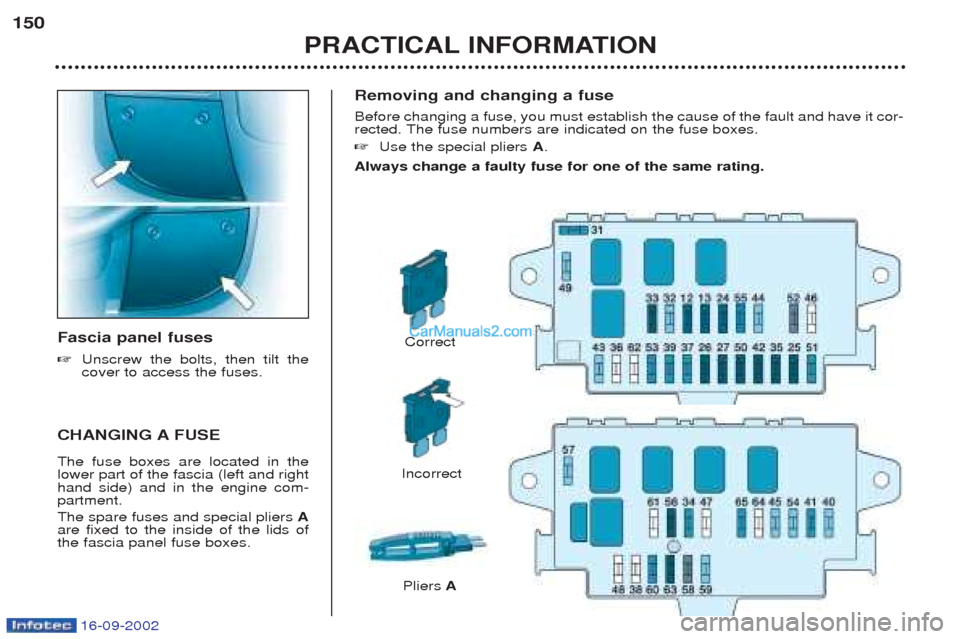
16-09-2002
Removing and changing a fuse Before changing a fuse, you must establish the cause of the fault and have it cor-
rected. The fuse numbers are indicated on the fuse boxes. ☞Use the special pliers A.
Always change a faulty fuse for one of the same rating.
CHANGING A FUSE The fuse boxes are located in the lower part of the fascia (left and righthand side) and in the engine com-partment. The spare fuses and special pliers A
are fixed to the inside of the lids of the fascia panel fuse boxes.
Fascia panel fuses ☞
Unscrew the bolts, then tilt the cover to access the fuses.
Correct
Incorrect
PRACTICAL INFORMATION
150
Pliers
A
Page 152 of 182
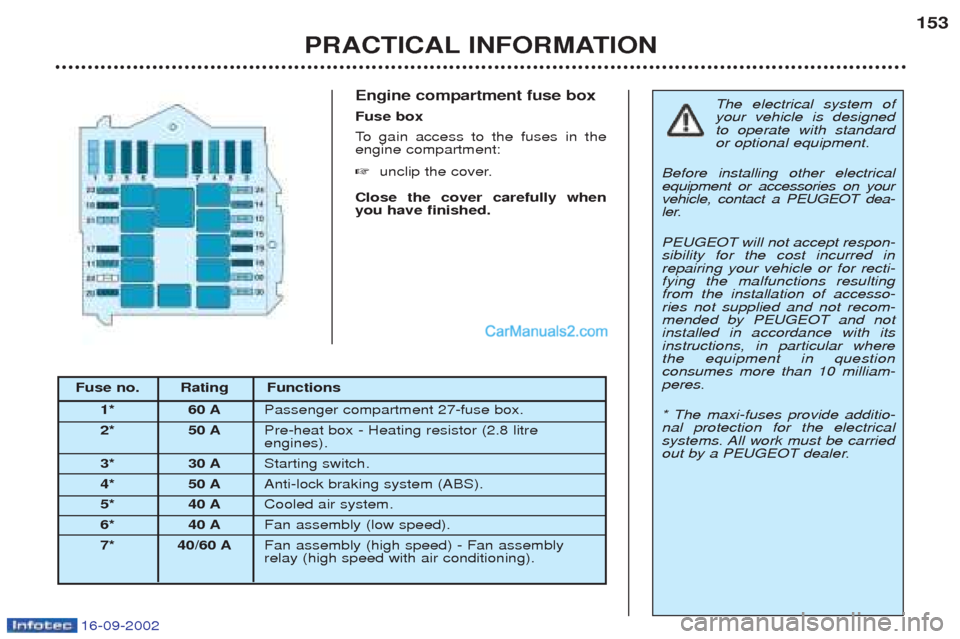
16-09-2002
Engine compartment fuse box Fuse box
To gain access to the fuses in the
engine compartment: ☞ unclip the cover.
Close the cover carefully when you have finished.
PRACTICAL INFORMATION 153
The electrical system of your vehicle is designedto operate with standardor optional equipment.
Before installing other electricalequipment or accessories on yourvehicle, contact a PEUGEOT dea-
ler. PEUGEOT will not accept respon- sibility for the cost incurred inrepairing your vehicle or for recti-fying the malfunctions resultingfrom the installation of accesso-ries not supplied and not recom-mended by PEUGEOT and notinstalled in accordance with itsinstructions, in particular wherethe equipment in questionconsumes more than 10 milliam-peres. * The maxi-fuses provide additio- nal protection for the electrical
systems. All work must be carried
out by a PEUGEOT dealer.
Fuse no. Rating Functions 1* 60 A Passenger compartment 27-fuse box.
2* 50 A Pre-heat box - Heating resistor (2.8 litre engines).
3* 30 A Starting switch.
4* 50 A Anti-lock braking system (ABS).
5* 40 A Cooled air system.
6* 40 A Fan assembly (low speed).
7* 40/60 A Fan assembly (high speed) - Fan assemblyrelay (high speed with air conditioning).
Page 153 of 182
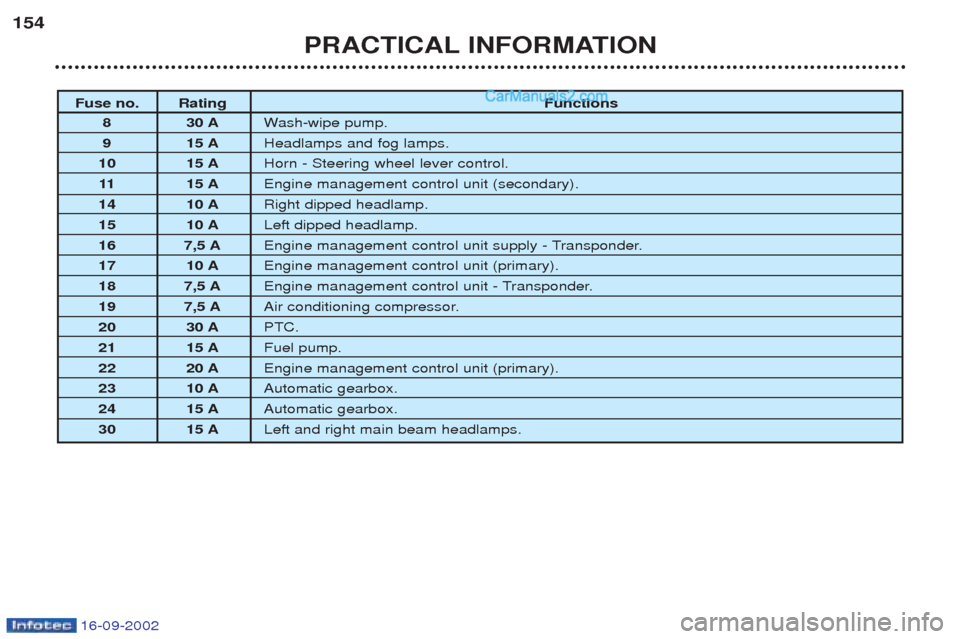
16-09-2002
Fuse no. Rating Functions
8 30 AWash-wipe pump.
9 15 AHeadlamps and fog lamps.
10 15 A Horn - Steering wheel lever control.
11 15 AEngine management control unit (secondary).
14 10 A Right dipped headlamp.
15 10 A Left dipped headlamp.
16 7,5 A Engine management control unit supply - Transponder.
17 10 A Engine management control unit (primary).
18 7,5 A Engine management control unit - Transponder.
19 7,5 A Air conditioning compressor.
20 30 A PTC.
21 15 A Fuel pump.
22 20 A Engine management control unit (primary).
23 10 A Automatic gearbox.
24 15 A Automatic gearbox.
30 15 A Left and right main beam headlamps.
PRACTICAL INFORMATION
154
Page 154 of 182
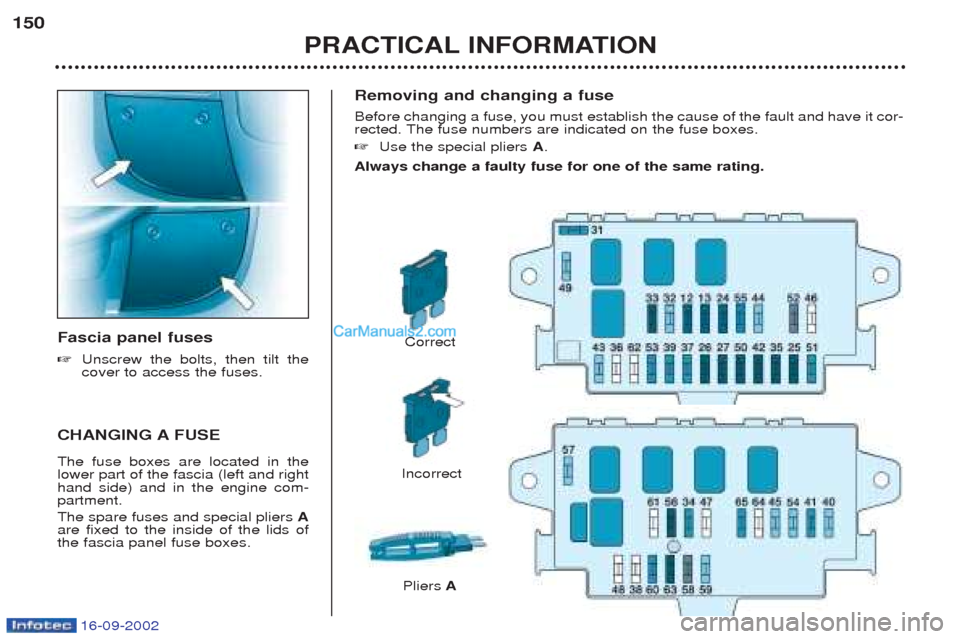
16-09-2002
Removing and changing a fuse Before changing a fuse, you must establish the cause of the fault and have it cor-
rected. The fuse numbers are indicated on the fuse boxes. ☞Use the special pliers A.
Always change a faulty fuse for one of the same rating.
CHANGING A FUSE The fuse boxes are located in the lower part of the fascia (left and righthand side) and in the engine com-partment. The spare fuses and special pliers A
are fixed to the inside of the lids of the fascia panel fuse boxes.
Fascia panel fuses ☞
Unscrew the bolts, then tilt the cover to access the fuses.
Correct
Incorrect
PRACTICAL INFORMATION
150
Pliers
A
Page 155 of 182
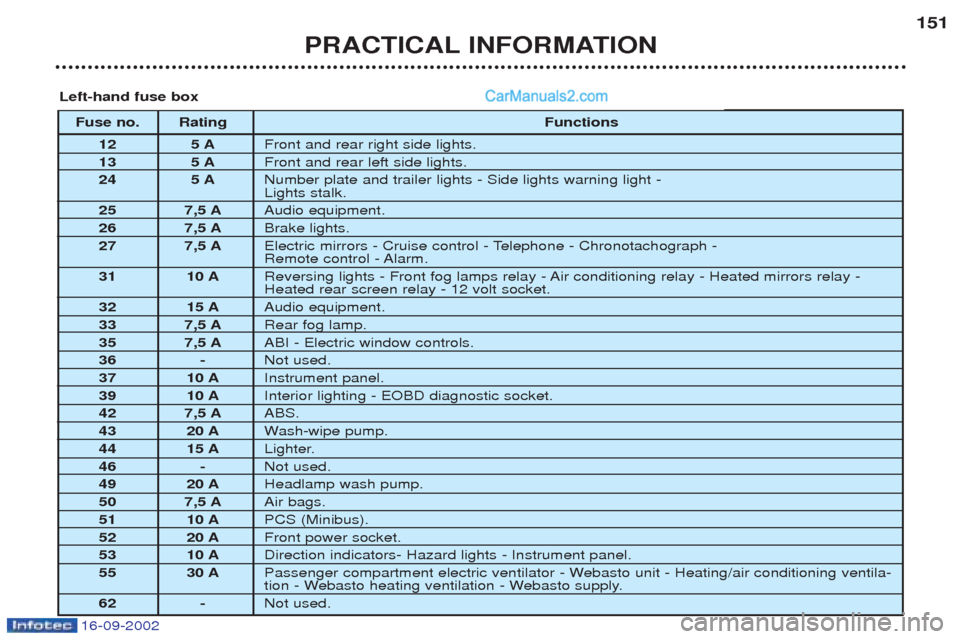
16-09-2002
PRACTICAL INFORMATION151
Fuse no. Rating
Functions
12 5 A Front and rear right side lights.
13 5 A Front and rear left side lights.
24 5 A Number plate and trailer lights - Side lights warning light - Lights stalk.
25 7,5 A Audio equipment.
26 7,5 A Brake lights.
27 7,5 A Electric mirrors - Cruise control - Telephone - Chronotachograph -
Remote control - Alarm.
31 10 A Reversing lights - Front fog lamps relay - Air conditioning relay - Heated mirrors relay -Heated rear screen relay - 12 volt socket.
32 15 A Audio equipment.
33 7,5 A Rear fog lamp.
35 7,5 A ABI - Electric window controls.
36 - Not used.
37 10 A Instrument panel.
39 10 A Interior lighting - EOBD diagnostic socket.
42 7,5 A ABS.
43 20 A Wash-wipe pump.
44 15 A Lighter.
46 - Not used.
49 20 A Headlamp wash pump.
50 7,5 A Air bags.
51 10 A PCS (Minibus).
52 20 A Front power socket.
53 10 A Direction indicators- Hazard lights - Instrument panel.
55 30 A Passenger compartment electric ventilator - Webasto unit - Heating/air conditioning ventila-
tion - Webasto heating ventilation - Webasto supply.
62 - Not used.
Left-hand fuse box
Page 156 of 182
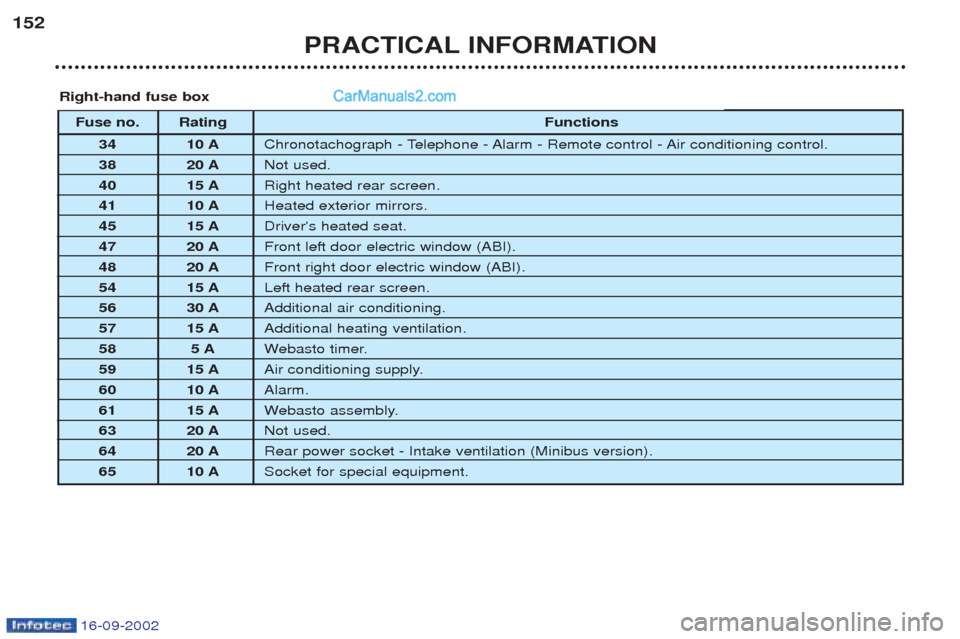
16-09-2002
PRACTICAL INFORMATION
152
Fuse no. Rating
Functions
34 10 A Chronotachograph - Telephone - Alarm - Remote control - Air conditioning control.
38 20 A Not used.
40 15 A Right heated rear screen.
41 10 A Heated exterior mirrors.
45 15 A Driver's heated seat.
47 20 A Front left door electric window (ABI).
48 20 A Front right door electric window (ABI).
54 15 A Left heated rear screen.
56 30 A Additional air conditioning.
57 15 A Additional heating ventilation.
58 5 A Webasto timer.
59 15 A Air conditioning supply.
60 10 A Alarm.
61 15 A Webasto assembly.
63 20 A Not used.
64 20 A Rear power socket - Intake ventilation (Minibus version).
65 10 A Socket for special equipment.
Right-hand fuse box
Page 157 of 182
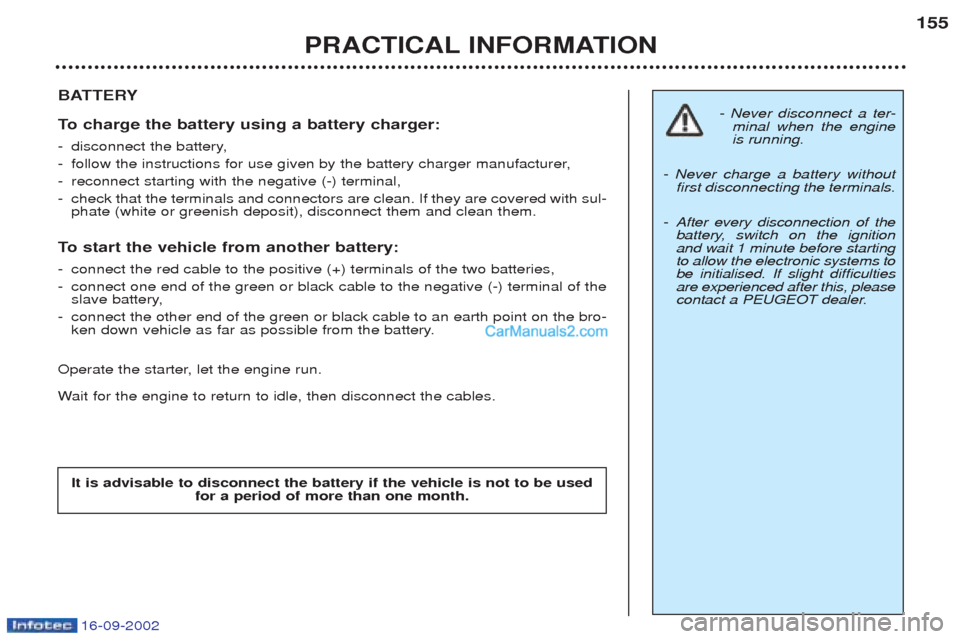
16-09-2002
PRACTICAL INFORMATION155
BATTERY
To
charge the battery using a battery charger:
- disconnect the battery,
- follow the instructions for use given by the battery charger manufacturer,
- reconnect starting with the negative (-) terminal,
- check that the terminals and connectors are clean. If they are covered with sul- phate (white or greenish deposit), disconnect them and clean them.
To start the vehicle from another battery:
- connect the red cable to the positive (+) terminals of the two batteries,
- connect one end of the green or black cable to the negative (-) terminal of the
slave battery,
- connect the other end of the green or black cable to an earth point on the bro-
ken down vehicle as far as possible from the battery.
Operate the starter, let the engine run. W ait for the engine to return to idle, then disconnect the cables.
- Never disconnect a ter-
minal when the engine is running.
- Never charge a battery without first disconnecting the terminals.
- After every disconnection of the
battery, switch on the ignitionand wait 1 minute before startingto allow the electronic systems tobe initialised. If slight difficultiesare experienced after this, please
contact a PEUGEOT dealer.
It is advisable to disconnect the battery if the vehicle is not to be used for a period of more than one month.
Page 158 of 182
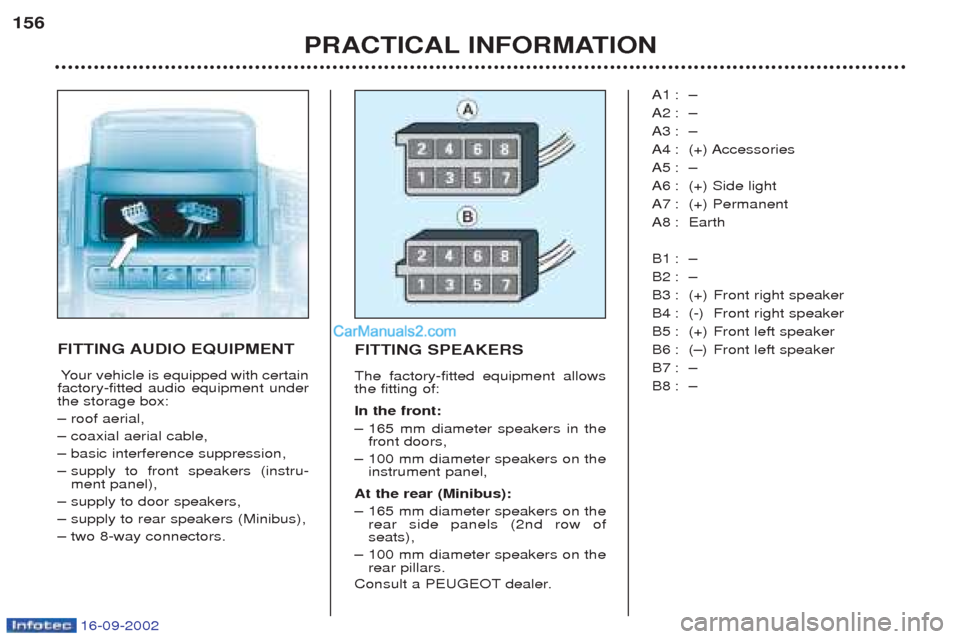
16-09-2002
PRACTICAL INFORMATION
156
FITTING AUDIO EQUIPMENT
Y our vehicle is equipped with certain
factory-fitted audio equipment under the storage box: Ð roof aerial,
Ð coaxial aerial cable,
Ð basic interference suppression,
Ð supply to front speakers (instru- ment panel),
Ð supply to door speakers,
Ð supply to rear speakers (Minibus),
Ð two 8-way connectors. FITTING SPEAKERS The factory-fitted equipment allows the fitting of: In the front: Ð
165 mm diameter speakers in the front doors,
Ð 100 mm diameter speakers on theinstrument panel,
At the rear (Minibus): Ð 165 mm diameter speakers on the rear side panels (2nd row ofseats),
Ð 100 mm diameter speakers on therear pillars.
Consult a PEUGEOT dealer. A1 : Ð
A2 : Ð
A3 : Ð
A4 : (+) Accessories
A5 : Ð
A6 : (+) Side light
A7 : (+) Permanent
A8 : Earth
B1 : Ð
B2 : Ð
B3 : (+) Front right speaker
B4 : (-) Front right speaker
B5 : (+) Front left speaker
B6 : (Ð) Front left speaker
B7 : Ð
B8 : Ð
Page 159 of 182
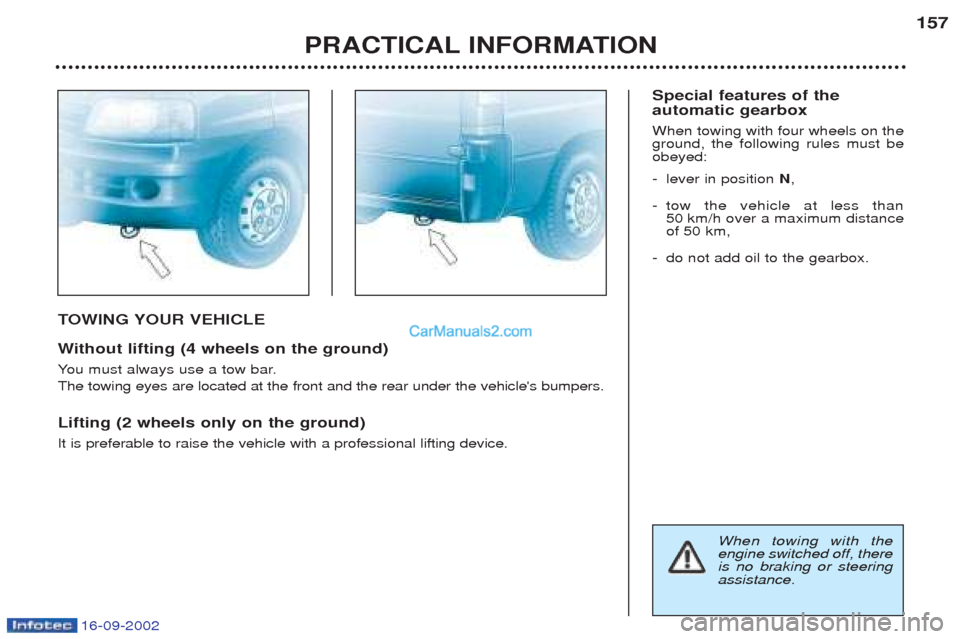
16-09-2002
TOWING YOUR VEHICLE
W ithout lifting (4 wheels on the ground)
Y ou must always use a tow bar.
The towing eyes are located at the front and the rear under the vehicle's bumpers. Lifting (2 wheels only on the ground) It is preferable to raise the vehicle with a professional lifting device. Special features of the automatic gearbox When towing with four wheels on the ground, the following rules must beobeyed: -
lever in position N,
- tow the vehicle at less than
50 km/h over a maximum distanceof 50 km,
- do not add oil to the gearbox.
PRACTICAL INFORMATION 157
When towing with the engine switched off, thereis no braking or steeringassistance.
Page 160 of 182
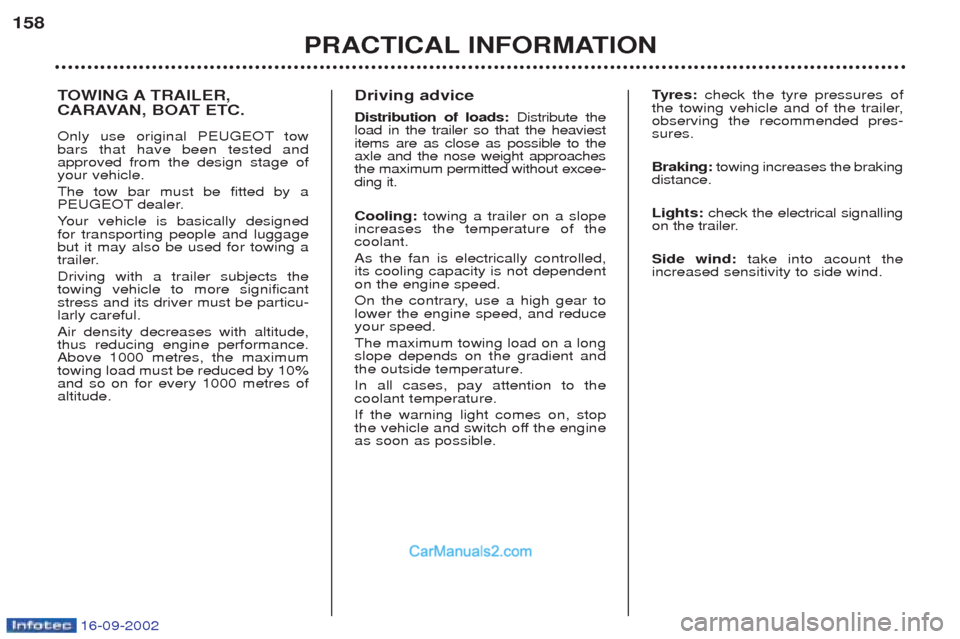
16-09-2002
TOWING A TRAILER,
CARAVAN, BOAT ETC.
Only use original PEUGEOT tow bars that have been tested andapproved from the design stage ofyour vehicle. The tow bar must be fitted by a
PEUGEOT dealer. Y our vehicle is basically designed
for transporting people and luggage but it may also be used for towing a
trailer. Driving with a trailer subjects the towing vehicle to more significantstress and its driver must be particu-larly careful. Air density decreases with altitude, thus reducing engine performance.Above 1000 metres, the maximumtowing load must be reduced by 10%and so on for every 1000 metres ofaltitude. Driving advice Distribution of loads:
Distribute the
load in the trailer so that the heaviest items are as close as possible to theaxle and the nose weight approachesthe maximum permitted without excee-ding it. Cooling: towing a trailer on a slope
increases the temperature of the coolant. As the fan is electrically controlled, its cooling capacity is not dependenton the engine speed.
On the contrary, use a high gear to lower the engine speed, and reduceyour speed. The maximum towing load on a long slope depends on the gradient andthe outside temperature. In all cases, pay attention to the coolant temperature. If the warning light comes on, stop
the vehicle and switch off the engineas soon as possible. T
yres: check the tyre pressures of
the towing vehicle and of the trailer,observing the recommended pres-sures. Braking: towing increases the braking
distance.Lights: check the electrical signalling
on the trailer.Side wind: take into acount the
increased sensitivity to side wind.
PRACTICAL INFORMATION
158